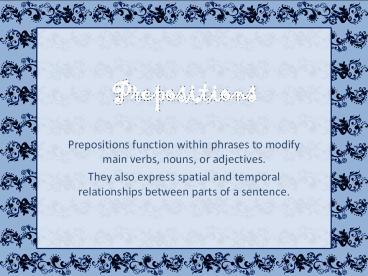Prepositions PowerPoint PPT Presentation
1 / 7
Title: Prepositions
1
Prepositions
- Prepositions function within phrases to modify
main verbs, nouns, or adjectives. - They also express spatial and temporal
relationships between parts of a sentence.
2
For Example
- 1. Location at, on, in Prepositions differ
according to the number of dimensions they refer
to. We can group them into three classes using
concepts from geometry point, surface, and
area/volume. - a. Point (at) Prepositions in this group
indicate that the noun that follows them is
treated as a point in relation to which another
object is positioned. - b. Surface (on) Prepositions in this group
indicate that the position of an object is
defined with respect to a surface on which it
rests. - c. Area/Volume (in) Prepositions in this group
indicate that an object lies within the
boundaries of an area or within the confines of a
volume.
3
For Example
- 2. Direction to, on(to), in(to) These
prepositions express movement toward something.
To, into, and onto correspond respectively to the
prepositions of location at, in, and on. Each
pair can be defined by the same spatial relations
of point, line/surface, or area/volume. - 3. Temporal relations Prepositions also express
how objects relate temporally. Prepositions can
express a point in time or an extended time. - a. On, at, and in are each used to express
similar relations as their spatial counterparts. - b. Since, by, for, and from-to are used to
express extended time.
4
Examples
- 1. We arrived ____ the house ____ the afternoon.
- 2. The waiter was ____ our table immediately.
- 3. We have not seen our waiter _____ we arrived.
- 4. The soccer player leaped ____ the ball.
- 5. The tiger jumped _____ my face.
- 6. The tiger jumped _____ the trap.
- 7. I went ____ the store today.
- 8. A light appeared ____ the window.
- 9. The cattle will graze ____ the open range ____
the whole summer. - 10. Three hockey players are ____ the ice.
- 11. The cowboy rode _____ the setting sun.
- 12. Three boxers are ____ the ring.
- 13. The play ran _____ September ____ November.
- 14. The water spilled _____ the floor.
in
at
in
on
at
for
on
since
into
to
in
onto
from
into
to
to
onto
5
Prepositions To and For
- For is a personal and personally limiting
preposition and expresses a proprietary
relationship. Also, for refers to temporal
duration (ex I went to England for two weeks)
and motivation. - To is a quantitative, directional preposition and
should be used to explain the impersonal
connection between objects.
6
For Example
- 1. For
- a. Speak for myself. Here for refers to motive
and is personally limiting and proprietary. The
emphasis is as follows I speak on my own
behalf no one else does it for me. - b. This is my first time for a visit. This
sentence lays more stress on the personal motive
for the visit. This preposition stresses the
relationship between the visitor and the visitee.
- 2. To Speak to myself. Here to explains the
direction of the conversation. - 3. Infinitives This is my first time to
visit. To visit is an infinitive not a
preposition. This sentence lays stress on the
action of the visit. An adverb could be added to
inform the reader of the specific type of action
(personal visit, professional visit . . . etc.).
7
Examples
- 1. (Direction) I went ___ the bank to deposit my
check. - 2. (Personal) I am waiting ___ the ambulance.
- 3. (Motive) John left ___ France where he hopes
to study French culture. - 4. (Direction) Thomas is leaving to go ___
England tomorrow.
- 5. (Motive) The bookstore closed ___
convocation. - 6. (Direction) The clerk left to go ___ the
chapel. - 7. (Motive) The clerk left ___ the chapel.
- 8. (Direction) Sally wants to go ___ the lake.
- 9. (Personal) John spoke ___ himself.
- 10. (Direction) John spoke ___ himself.
for
to
to
for
for
for
to
for
to
to

